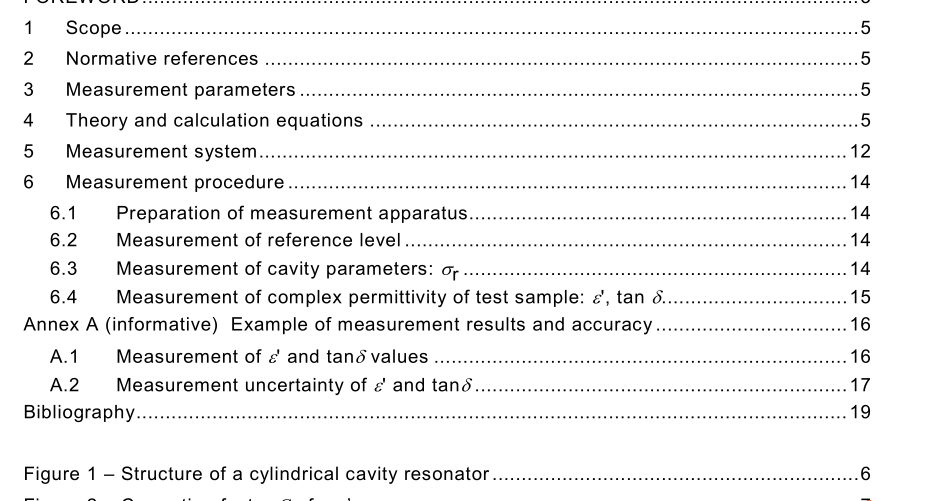IEC 62810-2015 pdf Cylindrical cavity method to measure the complex permittivity of low-loss dielectric rods

This International Standard relates to a measurement method for complex permittivity of a dielectric rod at microwave frequency. This method has been developed to evaluate the dielectric properties of low-loss materials in coaxial cables and electronic devices used in microwave systems. It uses the TM 01 0 mode in a circular cylindrical cavity and presents accurate measurement results of a dielectric rod sample, where the effect of sample insertion holes is taken into account accurately on the basis of the rigorous electromagnetic analysis. In comparison with the conventional method described in IEC 60556 [2] 1 , this method has the following characteristics: • the values of the relative permittivity ε ‘ and loss tangent tan d of a dielectric rod sample can be measured accurately and non-destructively; • the measurement accuracy is within 1 ,0 % for ε ‘ and within 20 % for tan d ; • the effect of sample insertion holes is corrected using correction charts presented;
where correction factors C 1 and C 2 , due to the sample insertion holes and errors included in the perturbation formulas, are calculated numerically by using the Ritz-Galerkin method [3][5], as shown in Figure 2 and Figure 3, and the corresponding data are listed in detail in Table 1 , 2, and 3. The missing data of C 1 and C 2 can be obtained by interpolation or extrapolation from the tables. The correction factors shown in these figures are calculated for the cavity with D = 76,5 mm, H = 20,0 mm, d 2 = 3,0 mm, and g = 1 0,0 mm, where the resonant frequency is about 3 GHz. C 1 is also used for a cavity having the same aspect ratios as H/D, d 2 /D and g/D.
Figure 4 shows a schematic diagram of two equipment systems required for microwave measurement. For the measurement of dielectric properties, only the information on the amplitude of transmitted power is needed, that is, the information on the phase of the transmitted power is not required. Therefore, a scalar network analyser can be used for the measurement shown in Figure 4a. However, a vector network analyser, as shown in Figure 4b, has an advantage in precision of the measurement.
- Previous:IEC 62826-2014 pdf Surface cleaning appliances – Floor treatment machines with or without traction drive, for commercial use – Methods of measuring the performance
- Next:IEC 62705-2014 pdf Nuclear power plants – Instrumentation and control important to safety – Radiation monitoring systems (RMS): Characteristics and lifecycle
- ISO IEC 27050-4-2021 pdf Information technology — Electronic discovery — Part 4: Technical readiness
- ISO IEC 27036-1-2021 pdf Cybersecurity — Supplier relationships — Part 1: Overview and concepts
- ISO IEC 27013-2021 pdf Information security, cybersecurity and privacy protection — Guidance on the integrated implementation of ISO/IEC 27001 and ISO/IEC 20000-1
- ISO IEC 26580-2021 pdf Software and systems engineering — Methods and tools for the feature- based approach to software and systems product line engineering
- ISO IEC 24735-2021 pdf Information technology — Office equipment — Method for measuring digital copying productivity
- ISO IEC 24711-2021 pdf Information technology — Office equipment — Method for the determination of ink cartridge yield for colour inkjet printers and multi- function devices that contain printer components
- ISO IEC 23544-2021 pdf Information Technology — Data centres — Application Platform Energy Effectiveness (APEE)
- ISO IEC 23510-2021 pdf Information technology — 3D printing and scanning — Framework for an Additive Manufacturing Service Platform (AMSP)
- ISO IEC 23127-1-2021 pdf Information technology — Learning, education, and training — Metadata for facilitators of online learning — Part 1: Framework
- ISO IEC 23126-2021 pdf Information technology for learning, education and training — Ubiquitous learning resource organization and description framework
- IEC 60938-1-2021 pdf Fixed inductors for electromagnetic interference suppression – Part 1: Generic specification
- IEC 61472-2-2021 pdf Live working – Minimum approach distances – Part 2: Method of determination of the electrical component distance for AC systems from 1,0 kV to 72,5 kV
- IEC 61453-2007 pdf Nuclear instrumentation – Scintillation gamma ray detector systems for the assay of radionuclides – Calibration and routine tests
- IEC 60358-3-2013 pdf Coupling capacitors and capacitor dividers – Part 3: AC or DC coupling capacitor for harmonic-filters applications
- ISO IEC 27013-2021 pdf Information security, cybersecurity and privacy protection — Guidance on the integrated implementation of ISO/IEC 27001 and ISO/IEC 20000-1
- BS ISO IEC 15420-2009 pdf Information technology一 Automatic identification and data capture techniques EAN/UPC bar code symbology specification
- BS IEC 60860-2014 pdf Radiation protection instrumentation一 Warning equipment for criticality accidents
- BS ISO IEC 19762.5-2008 pdf Information technology一 Automatic identification and data capture (AIDC) techniques – Harmonized vocabulary Part 5: Locating systems
- ISO IEC 24735-2021 pdf Information technology — Office equipment — Method for measuring digital copying productivity
- ISO IEC 24711-2021 pdf Information technology — Office equipment — Method for the determination of ink cartridge yield for colour inkjet printers and multi- function devices that contain printer components